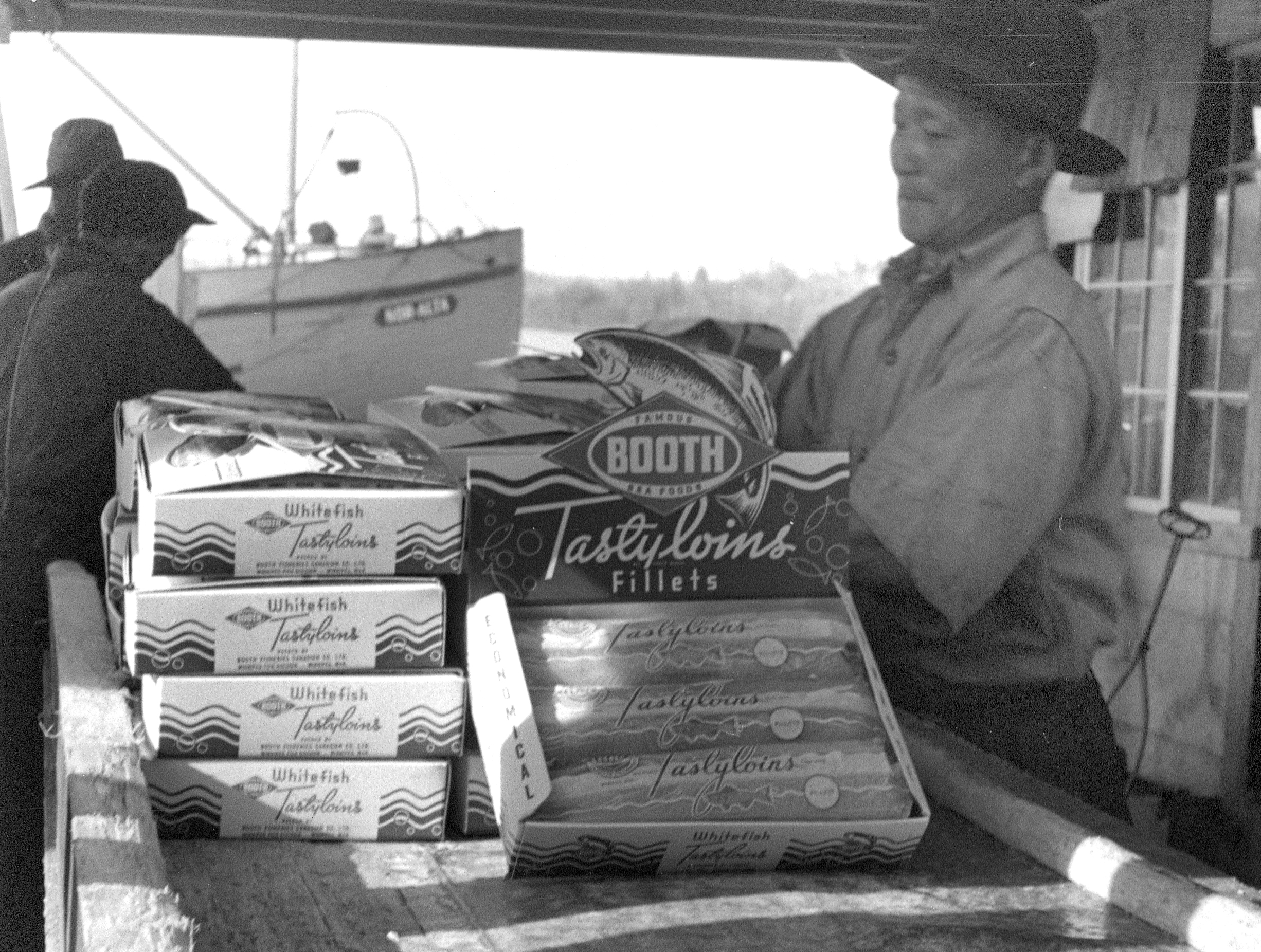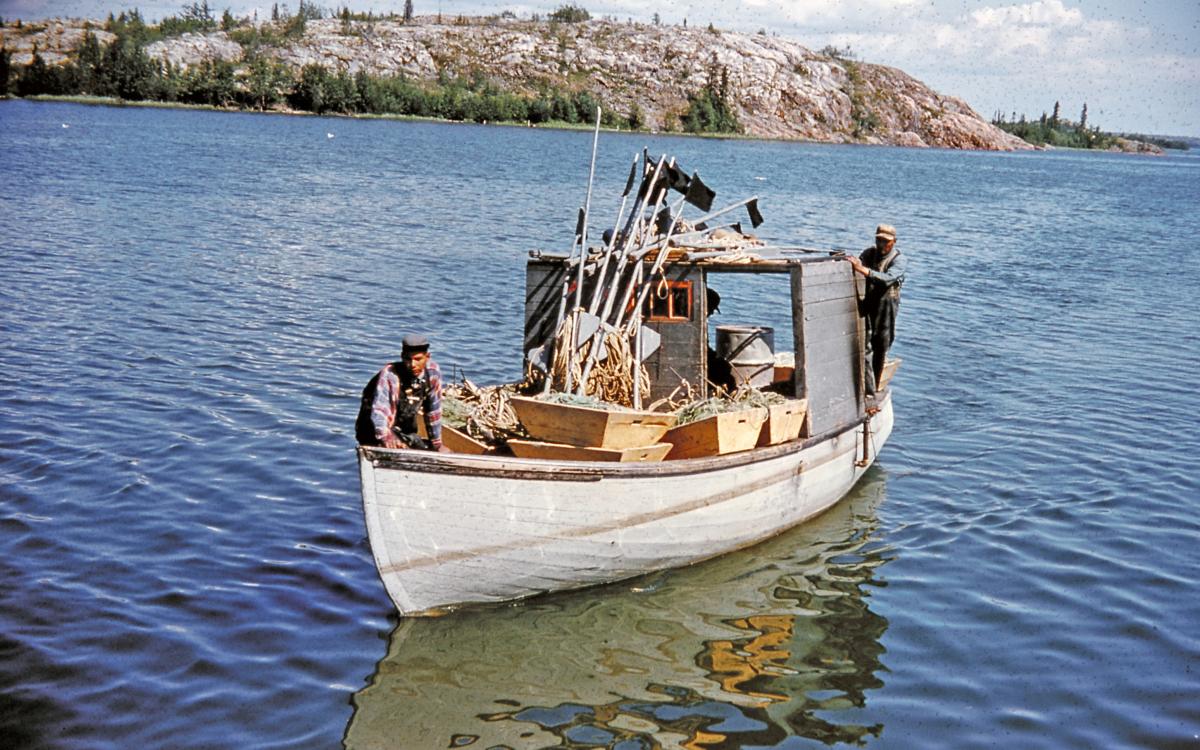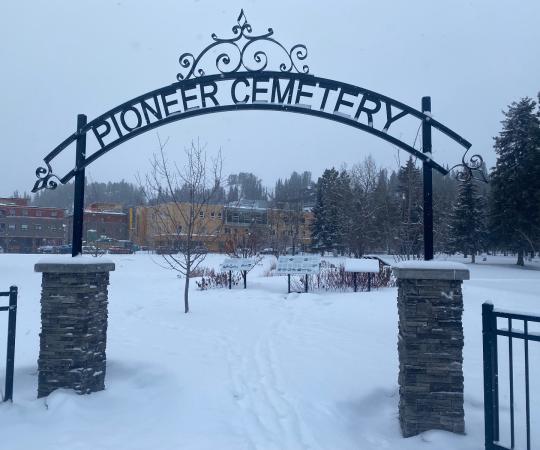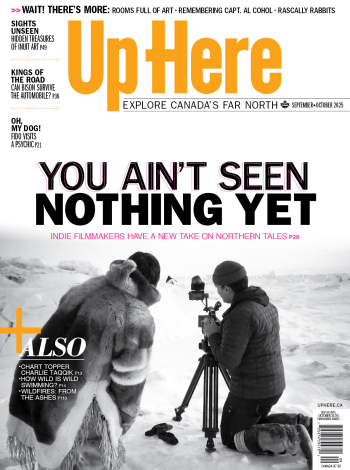When you turn your boat off the main lake and into Devil’s Channel there is always a feeling of relief. Great Slave Lake is huge and unsettled. Even the most benign marine forecast – winds south 7 knots, for example – can lead to a rough ride for most small boats. Devil’s Channel is a place of calm and safety, a narrow, five-kilometer-long channel between the shore and a large island called Gros Cap, located at the point where the North Arm meets the spectacular East Arm. It was in this sheltered location that commercial fishing made its debut north of sixty over 75 years ago.
The lean years of World War II had brought home the importance of food self-sufficiency to the Government of Canada. The demand for canned and cured fish increased sharply across North America as meat was rationed and shipped overseas to the military forces. This increased demand encouraged the expansion of fishing operations across the country. Large southern companies pressed the government to open both Great Slave Lake and Great Bear Lakes to commercial fishing.
In response to the increasing pressure, the Department of Fisheries sent scientists to both lakes in 1944 to analyse the level of domestic fishing and do a biological survey of fish stocks in both lakes. Dr. D.S. Rawson, a limnologist from the University of Saskatchewan, was hired to lead the research team. The potential development of these remote, “virgin” northern lakes provided scientists with, in the words of Rawson, “a unique opportunity for a program of fisheries research and conservation.”
Rawson and his team travelled by barge around Great Slave in the summer of 1944. He counted 75 nets set around the lake and concluded that eight communities had significant summer fisheries. He estimated that in that summer, the community of Fort Resolution (population 675) harvested one million pounds (450,000 kg) of fish. Most of the harvest was whitefish and trout and was used mainly for dog food although some was for the table. Surplus fish were sold at the local trading posts fetching about a dollar for a stick of 10. During four days in early October, 1945, 10,000 inconnu were caught at the mouth of the Buffalo River, near Fort Resolution.
After only one summer of exploration, Dr. Rawson concluded that Great Slave could indeed support a substantial commercial fishery. His tentative estimate was that at least 3 million pounds (1.4 million kg) could safely be taken every year in addition to the domestic catch. This quota, he suggested, should be liable to annual review. He also concluded that commercial fishing on Great Bear Lake was not feasible. Based on this preliminary research, the Department of Fisheries authorized limited commercial fishing on the lake in 1944 and opened the lake in 1945 for export from the Northwest Territories.
Only one company, McInnes Products Corporation, who had been operating on Lake Athabasca for many years, was ready to take up the challenge. Originally known as the McInnes Fish Company, it was established in Edmonton in 1916 and had re-emerged in 1934 as the McInnes Products Corporation. It was one of the largest fish producers in western Canada.
On July 18, 1945, the RCMP issued one licence to McInnes Products Corporation for 42 fishermen. This licence entitled the company “to fish in the public waters of Great Slave Lake, at Gros Cap, with 42,000 yards of gill net of at least 51/2-inch mesh, for a fee of $420.00.” This was a temporary arrangement and individual licences were soon issued directly to the fishermen. The catch limit for the lake that year was 1.2 million pounds of whitefish and trout. In late July a number of barges from Lake Athabasca, equipped with freezing and filleting equipment, were floated down the Slave River and installed in Devil’s Channel, about 60 miles (100 km) from the mouth of the Slave River.
The first net was dropped by Len Cardinal from Fort Chipewyan. “We went down the Slave River to Great Slave Lake and crossed to Gros Cap. We set the first commercial net at 2:30 am on July 28, 1945. There were 24 little boats and ours was the first one out. We were at Matonabee Point. There was lots of fish.”
Because of low water levels on the Slave River, which was critical for transportation south, it was a short summer season, shutting down on September 16. Nonetheless, in less than two months, McInnes was able to process 1,205,000 pounds of trout and whitefish. The catch was processed and frozen at Gros Cap, barged across Great Slave, up the Slave River, portaged around the rapids at Fort Fitzgerald, and then barged further upstream on the Athabasca River to Waterways, a journey taking about 120 hours. In Waterways they were loaded onto refrigerated rail cars and shipped to Booth Fisheries in Chicago. McInnes had struck gold on Great Slave Lake.
McInnes ran a large operation. In 1946 they employed 175 people at Gros Cap and had a fleet of 25 fishing boats. The fisherman came from all over. Many had worked for McInnes on Lake Athabasca; some were Scandinavians and Icelanders from Lake Winnipeg; still others were Dene and Métis from around Great Slave Lake, Lake Athabasca and the lakes of northern Saskatchewan and Alberta. For many, the immense size of Great Slave Lake was a real shock. They often had to travel up to eight hours just to get to their fishing grounds, a distance unheard of on smaller southern lakes.
In the plant, the fish were cleaned, scaled, washed, filleted, packed in five-pound containers, wrapped in cellophane and quick-frozen. Quick-freezing was a relatively new process developed by American inventor, Clarence Birdseye. Birdseye had spent several years in Labrador as a fur trader and was impressed by the quick-freezing techniques used by the Inuit. The processes in the plant were overseen almost entirely by women, mainly Japanese and local Dene.
A group of Japanese Canadians, who had been interned in Alberta during the war, worked mainly in the processing plant and added a real international flavour to the isolated camp. Ninety-three-year-old J.J. Morin started fishing for McInnes in 1946 and remembers them well. “The Japanese had been working for McInnes on Lake Athabasca. There were about 60 families at Gros Cap. They lived in tents going up the hill. They were very nice people and mostly worked filleting and wrapping the fish. We didn’t really get to socialize too much with them because we were too busy. We got up at 2 a.m. to go to the nets and didn’t get back until about 3 or 4 in the afternoon. Then we ate and went to bed early.”
Ninety-year-old Lydia Nakamura Yatabe recalled her time at Gros Cap in a 2015 News/North article. She worked there in the summer of 1946 with other Japanese-Canadian women wrapping fish. The hours were long and the pay low, but she had fond memories of Great Slave Lake. “There was a group of boys from the University of Saskatchewan doing experimental work, and we got to know them quite well. They cooked fish for us and we had a good time singing and talking.”

Eight to ten engineers were required just to maintain all of the engines, generators and refrigerator units. They had a large shop and spare parts building behind the plant. Behind that were bunkhouses for plant staff. Farther up the hill was the main kitchen and the dining rooms where most of the crews were fed. Canvas tents dotted the shoreline of the channel, home to many families as well as single men. In 1948, the chief cook was an Englishman known only as Tommy. He was a good cook and famously baked a 98-pound bag of flour into bread every day. The camp store, located near the kitchen, supplied employees with most of the essentials they needed. Further inland, a large root cellar kept the vegetables fresh or at least edible. Along the shoreline was a small log cabin, the home of an ex-trapper called Shorty Bakstrom, also known as “The Mayor of Gros Cap.” He was the year-round caretaker and spent the winters alone, with only his dog team for company.
In 1947, Henry Villebrun’s family, like many others, travelled down the Slave River from Fort Chipewyan on Lake Athabasca, to Great Slave Lake, where they crossed to the north shore and the Gros Cap plant. “It was a good place”, remembers Villebrun. “There were lots of tent frames and barges, and two big cook houses. My mother worked on a barge, inspecting whitefish for parasites. A lot of the Japanese worked there too. There were lots of Japanese families and my best friend was a Japanese boy called Dennis. One day he almost drowned. He fell between two barges. Two Japanese guys pulled him out by his hair. He was lucky.”
With the completion of the all-weather road from Alberta to Hay River in 1948, many more fishing companies moved north, peaking at 14 in 1949. In response to this increase in activity, the quota on the lake was raised to 9 million pounds. Instead of shipping its fish products south up the Slave River, McInnes was now able to truck them directly from Hay River. However, as the Hay River fishery expanded, McInnes began to feel pressure because of the extra shipping costs it incurred boating its products across the lake. The company could pay its fishermen only half as much per pound as those working for the companies based in Hay River.
Prices paid to fisherman at Gros Cap in 1948 were: small dressed trout, 3 cents per pound; round whitefish, 2.5 cents per pound; dressed inconnu, 2 cents per pound; dressed pickerel, 3 cents per pound; and large trout (head off), 2 cents per pound. At the end of the season a bonus of .5 cents per pound was paid out. Labourers were paid $.65 per hour for a 48-hour work week, with time and half for overtime. Boats were rented to fisherman at rate of $125 to 150 per month depending on their size. Filleters were paid on a contract basis, 2 cents per pound of fillet. In 1946, J.J. Morin made $150 a month as crew on a boat. “At the end of the summer, I got a cheque for $450 and I felt rich.”
Sanitation problems began to plague the plant and in August 1951, an outbreak of typhoid fever hit the Gros Cap area. Eight active cases were reported and the plant was temporarily closed. Inspectors declared that the sanitary conditions in the camp were deplorable. All the workers were vaccinated and sanitary conditions were improved before the camp re-opened.
In 1954, McInnes decided to start shipping most of their fish fresh, not frozen, to Hay River on the Noralta, to be trucked south. Because they were now shipping fresh fish, more ice was needed and the ice house at Gros Cap was too small, causing slowdowns. The next year, they purchased an ice-making machine, but this was still too small for the operation.
In the fall of 1955, McInnes’ Dease Lake tug was towing the Mackenzie River paddle wheeler from Gros Cap to Hay River at the end of the season. A severe storm hit, scattering the fishing fleet all over the lake. As a last resort, the Mackenzie River was finally cut loose and washed up on a beach between Buffalo River and Hay River. The shore crew on board were rescued the next day when the storm abated. The Mackenzie River was towed to Hay River and dismantled.
Finally admitting that the company was unable to compete with the Hay River based outfits, McInnes ceased summer operations on Great Slave Lake after the 1960 season. The Gros Cap fish camp was abandoned. Remnants of the plant can still be found today, hidden in the willows of Devil’s Channel.
If you sit on the high rock promontory behind the camp location, it’s not hard to imagine a bustling camp smelling of fish and woodsmoke, the air thick with mosquitoes and the sounds of outboard motors and voices - young and old - talking in languages from around the lake and around the world.










